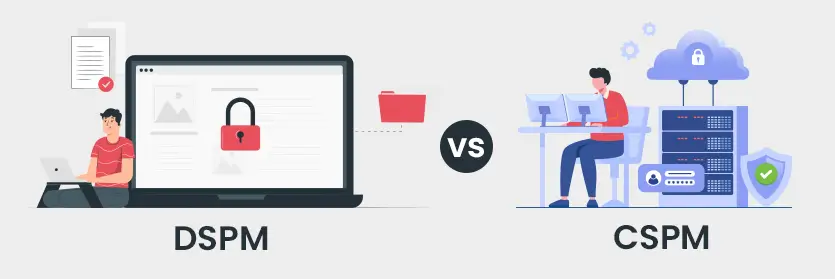
To do business in the modern world and remain competitive, businesses must shift from traditional network perimeters, initiate data democratization, integrate AI/ML solutions, and adopt cloud-based technologies. And that’s a fact. On the other hand, these technological advancements have also introduced new security vulnerabilities. The average data breach cost in 2024 is $4.88 million, a 10% increase from the previous year. The healthcare industry had the highest average data breach cost at nearly $9.77 million, while the financial sector was second at $6.08 million. To mitigate the security risks dwelling inside modern IT environments, companies need robust data security posture management (DSPM).
DSPM enables consistent management of data security threats and risks by continuously evaluating data security posture, identifying vulnerabilities, and implementing controls to reduce/mitigate those risks.
What is Data Security Posture Management (DSPM)?

DSPM is a cybersecurity technology that helps businesses identify sensitive information across multi-cloud services or environments. It also assesses vulnerabilities, security threats, and regulatory non-compliance risks. Data security posture management offers insights and automation to assist security teams in addressing data compliance and security issues and preventing recurrence.
For instance, businesses nowadays process and store sensitive data, including PHI and PII, intellectual property, financial data, etc. This data is spread across multiple databases, cloud environments, and more. DSPM helps secure this sensitive information and automate data discovery, detection, classification, protection, and monitoring processes. As the data volume and capacity grow, DSPM assists businesses in identifying their sensitive data, controlling access and usage, and implementing data protection practices.
DSPM vs CSPM

| Data Security Posture Management | Cloud Security Posture Management |
| DSPM focuses on handling data security posture, including storage, access, and processing. | CSPM helps in securing cloud infrastructure by continuously monitoring and remediating cloud misconfigurations. |
| Ensures data security and compliance throughout its lifecycle. | Ensures compliance and security of cloud environments. |
| Protects sensitive data by identifying data access and storage vulnerabilities. | Focuses on securing cloud resources, including networks, services, and storage. |
| Covers data assets, databases, encryption, data privacy, and access controls. | Covers cloud infrastructure like virtual machines, networks, cloud services, and containers. |
| Assists in identifying risks associated with data exposure, leakage, wrong access, and compliance violations. | Assists in identifying risks such as cloud misconfigurations, network expires, and policy violations. |
| Key features include data discovery, encryption validation, classification, compliance checks, and access controls. | Key features include cloud resource scanning, compliance monitoring, configuration management, and automated remediation. |
| Monitors where sensitive data is stored, how it is used, and who has access to it. | Monitors cloud infrastructure configurations for security misconfigurations and vulnerabilities. |
| Ensure compliance with GDPR, CCPA, HIPAA, and other data protection regulations. | Ensure compliance with PCI DSS, NIST, SOC 2, CIS, and other cloud-specific compliance standards. |
| Automates data classification, policy enforcement, and encryption management. | Automates remediation of cloud misconfigurations and policy enforcement. |
| Identify and protect sensitive data in hybrid cloud environments. | Secure multi-cloud environments by detecting configuration drifts and vulnerabilities. |
Core Components of DSPM

Data security posture management core components focus on ensuring data compliance, protection, and visibility across platforms. These components create an integrated and comprehensive process to secure sensitive data. Let’s take a look at some of the components of DSPM:
Data Discovery and Classification
Knowing where sensitive data lives is important. Data discovery creates an inventory that contains all sensitive data and helps identify where it’s stored. It also classifies all the data based on the regulatory frameworks governing it. Businesses can easily manage data access controls and decide what security protocols should be implemented to protect them.
Data Risk Assessment
Data security risk assessment starts with finding every environmental loophole. The process involves using automated tools to run regular checks against industry-specific data security standards and then creating tailored risk detection rules based on business requirements.
Real-time Monitoring
Ensuring critical business data protection is a continuous process that involves regularly scanning new data stores and identifying threats to data security. With real-time data monitoring, businesses can continuously supervise their data collection, storage, and usage. It would provide a holistic view of data and where, why, and how it is utilized.
Compliance and Reporting
Ensuring compliance with regulations and industry standards. It includes benchmarking, sending violation alerts, flagging security issues, and reporting compliance status.
Data Prioritization
This component prioritizes data based on its sensitivity level and the degree to which it is vulnerable to compromise. This allows businesses to identify potential attack paths and prioritize the data requiring urgent attention.
Top Benefits of Data Security Posture Management

The primary benefit of integrating DSPM is that it accelerates the process of keeping data safe and secure, no matter where it is. Unlike other security postures focusing on cloud, applications, devices, networks, identity, etc., DSPM’s main focus is data only. Let’s take a quick look at some of the benefits of implementing data security posture management:
- DSPM helps avoid legal actions and fines by auditing business policies against data protection rules and regulations, ensuring improved data security for partners and customers.
- Seamlessly connect with DevSecOps workflows for early risk mitigation whenever they appear in the app development lifecycle.
- Pinpoint abandoned data stores as they are easy targets for cyberattacks due to lack of supervision, and businesses can easily transfer them to affordable repositories for cost savings.
- It helps create data policies and controls (even across multi-cloud and SaaS environments) according to organizational needs and data sets.
- It enables automation to continuously monitor and optimize security posture while enabling teams to address high-priority data vulnerable to security breaches.
- DSPM helps secure all types of data, including data located in SaaS, PaaS, multi or public cloud, and hybrid or on-premises infrastructure.
Why Do You Need Data Security Posture Management?

Security tools and technologies protect sensitive data by restricting unauthorized network access or by identifying and blocking malicious behaviors by users, APIs, IoT devices, etc. Although these technologies have upscaled data security and threat detection and remediation capabilities, the rapid adoption of cloud-native technologies, AI, and ML has increased concerns regarding data security risks. These technologies don’t always address security vulnerabilities, leaving sensitive business data at risk of breaches and compliance violations.
One of the significant risks is ‘Shadow Data,’ which means data copied, replicated, or backed up to a location that’s not governed or managed by the same policies, security teams, or controls that operate the original data. The major contribution to shadow data is AI or ML modeling, which requires a lot of data. To train AI/ML models, businesses usually expand data access to more users, some of whom don’t even have the basic knowledge of data security and governance. And the adoption of a hybrid or multi-cloud environment spreads this risk further.
How can Tx assist with Data Security Posture Management?

Tx can assist with Data Security Posture Management (DSPM) by providing a comprehensive approach to protect and manage your data security across various environments, including cloud, hybrid, and on-premises systems. Here’s how Tx can help:
- We identify vulnerabilities, misconfigurations, and potential risks in your data environment, offering actionable insights for mitigation.
- Tx uses AI-driven tools to monitor and detect abnormal data activity, ensuring proactive threat detection and compliance.
- We implement robust encryption, access controls, and policies to safeguard sensitive data at every stage.
- Tx ensures adherence to regulatory standards such as GDPR, HIPAA, and PCI-DSS by auditing data security practices and aligning them with industry best practices.
- Our team is prepared to respond to data security incidents swiftly, minimizing potential damage and ensuring business continuity.
Our in-house accelerator, Tx-Secure, is a powerful security operations platform for SIEM, compliance monitoring, threat intelligence, and more. The tool offers advanced security analytics, threat detection capabilities, and comprehensive monitoring, analysis, and response for security-related data across your business infrastructure. Its key capabilities include the following:
- Real-time threat detection
- Vulnerability management
- File integrity monitoring
- Malware detection
- Compliance monitoring
- Network intrusion detection
- Log management and analysis
- Comprehensive visibility
Summary
Data security posture management (DSPM) is an integral part of modern business operations and data security strategy. Data’s growing demand and value raise concerns about the consequences of data mishandling, which is why businesses should prioritize DSPM. By leveraging DSPM, businesses can secure sensitive data, improve brand value, and maintain customer trust. Tx, the leading security testing services provider, can assist in establishing a strong data security platform. It will help you automate data discovery, risk remediation, prioritization, and monitoring processes.
Ready to secure your data with DSPM? Contact Tx today to learn how we can help protect your business from cyber threats.
Discover more
Get in Touch
Stay Updated
Subscribe for more info




